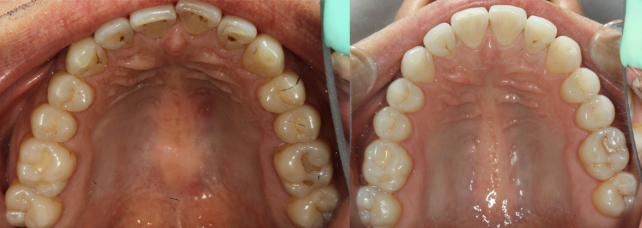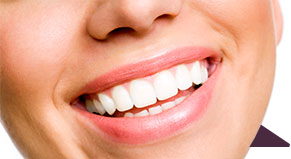AcceleDent for Invisalign: Cutting Treatment Time in Half
March 16th, 2017

Let’s face it – No one wants to wear braces, even if they are virtually undetectable. But what if we told you that we can potentially cut the amount of time you have to wear them in half by using a combination of Invisalign with AcceleDent Aura?
Invisalign is used to straighten teeth, adjust overbites, and close gaps using plastic trays that are nowhere near as noticeable as traditional braces. Invisalign trays are designed to be changed every two weeks until you achieve the results you desire. People choose Invisalign because of their effectiveness, and because they are difficult to detect. When used in combination with AcceleDent Aura, Invisalign can be one of the most effective treatments used to realign teeth.
What Is AcceleDent Aura?
AcceleDent Aura is a simple-to-use, hands-free device that was designed to accelerate orthodontic treatment. There are two notable advantages to using AcceleDent Aura – it cuts your treatment time in half and it reduces discomfort.
AcceleDent Aura comes with an Activator, a mouthpiece, and a USB extension cable, which can be plugged directly into a computer to view patient usage history.
Using AcceleDent Aura is easy. By inserting the mouthpiece, which is fitted around your existing Invisalign aligners, and turning on the Activator for 20 minutes every day, AcceleDent Aura will speed up your teeth movement. This technology, known as SoftPulse Technology®, emits vibrations – micropulses – that are even more gentle than an electric toothbrush. These pulses help your teeth move into the correct position up to 50% faster, while keeping your teeth and bone structure strong.
Using both Invisalign and AcceleDent Aura together is the perfect method for busy people to realign their teeth to provide natural looking and long lasting results. This allows you to achieve the perfect smile you’re looking for without having to wait as long as you would with traditional procedures.
Why Dentists Love It
Since its production in 2009, many dentists have been prescribing AcceleDent Aura as a way to effectively help move teeth. Dentists tend to like prescribing it for their patients because it’s faster, FDA-cleared, and virtually painless – many patients say they experienced little to no pain when using AcceleDent Aura.
AcceleDent Aura is one of the most effective tools available for your realignment treatment in order to safely speed up the process of your treatment.
If you have any questions about using AcceleDent Aura with Invisalign, or about your dental health, please contact us today to make an appointment.


 We use our tongues to talk, drink, and eat. Any time they get hurt, it can feel like the pain is magnified ten-fold. Usually, pain on the underside of the tongue is caused by a minor injury or ailment and isn’t cause for too much concern. Here are 5 reasons the underside of your tongue may hurt.
We use our tongues to talk, drink, and eat. Any time they get hurt, it can feel like the pain is magnified ten-fold. Usually, pain on the underside of the tongue is caused by a minor injury or ailment and isn’t cause for too much concern. Here are 5 reasons the underside of your tongue may hurt. For teens and adults considering Invisalign, the nearly invisible aligner treatment is a big draw. But the fear of developing a lisp is enough to make many people reconsider. After all, what’s the point of investing in invisible orthodontic work if one of the potential side effects would quickly reveal the secret?
For teens and adults considering Invisalign, the nearly invisible aligner treatment is a big draw. But the fear of developing a lisp is enough to make many people reconsider. After all, what’s the point of investing in invisible orthodontic work if one of the potential side effects would quickly reveal the secret? There’s nothing like a little Chicago crosstown rivalry to get the blood boiling. While we’ll leave the big game analysis up to the professional players, we’re here to compare the teams in a new, but equally important way: by their mascot’s teeth. After all, who wants to follow a team that represents bad dental health?
There’s nothing like a little Chicago crosstown rivalry to get the blood boiling. While we’ll leave the big game analysis up to the professional players, we’re here to compare the teams in a new, but equally important way: by their mascot’s teeth. After all, who wants to follow a team that represents bad dental health? Babies are incredibly cute - especially your own baby. But what happens when your baby’s teeth start coming through and you notice a big gap between their front teeth? You may start to wonder if there’s something wrong with your baby’s mouth, or if you did something wrong. Before you rush your baby to the dentist, read this article. It’s likely that your baby’s gaps are completely normal! In fact, they can actually be a good sign.
Babies are incredibly cute - especially your own baby. But what happens when your baby’s teeth start coming through and you notice a big gap between their front teeth? You may start to wonder if there’s something wrong with your baby’s mouth, or if you did something wrong. Before you rush your baby to the dentist, read this article. It’s likely that your baby’s gaps are completely normal! In fact, they can actually be a good sign. Open bites can be a real hassle. Not only can they make your smile look strange, but they can also lead to serious dental problems. Braces, bite blocks and headgear used to be your only option for treating dental open bites. But nowadays, we have a much more discreet and much less invasive way to fix open bites:
Open bites can be a real hassle. Not only can they make your smile look strange, but they can also lead to serious dental problems. Braces, bite blocks and headgear used to be your only option for treating dental open bites. But nowadays, we have a much more discreet and much less invasive way to fix open bites:  Do you notice that your top teeth bite down on the inside of your bottom teeth? If so, you might have a crossbite. Though crossbites don’t necessary cause direct pain right off the bat, they can lead to serious issues in the future. The only way to treat crossbite back in the day was with braces or expanders. Thankfully, there are less invasive ways to get your crossbite corrected today. We’re going to discuss how
Do you notice that your top teeth bite down on the inside of your bottom teeth? If so, you might have a crossbite. Though crossbites don’t necessary cause direct pain right off the bat, they can lead to serious issues in the future. The only way to treat crossbite back in the day was with braces or expanders. Thankfully, there are less invasive ways to get your crossbite corrected today. We’re going to discuss how  The last thing you want is yellow teeth after years of wearing braces. But unfortunately, it’s a very common occurrence. If you don’t take care of your mouth while you’re wearing braces, you might be surprised to see white squares where your braces were on yellow-stained teeth after your dentist removes them. Thankfully, it’s easy to avoid this experience. Here are some reasons why people get yellow teeth after braces and how to prevent this from happening. We’ll also talk about how you can fix stained teeth after braces.
The last thing you want is yellow teeth after years of wearing braces. But unfortunately, it’s a very common occurrence. If you don’t take care of your mouth while you’re wearing braces, you might be surprised to see white squares where your braces were on yellow-stained teeth after your dentist removes them. Thankfully, it’s easy to avoid this experience. Here are some reasons why people get yellow teeth after braces and how to prevent this from happening. We’ll also talk about how you can fix stained teeth after braces. Having an underbite is no fun. Not only does can it look strange, but it may also cause serious health issues. Back in the day, the only way to fix underbites was with surgery, braces or expanders. Thankfully, there are less invasive and revealing ways to deal with underbites nowadays. We’re here to tell you how
Having an underbite is no fun. Not only does can it look strange, but it may also cause serious health issues. Back in the day, the only way to fix underbites was with surgery, braces or expanders. Thankfully, there are less invasive and revealing ways to deal with underbites nowadays. We’re here to tell you how 
 Nobody likes having crooked teeth. They don’t give you the most beautiful smile in the world and they’re hard to take care of. Ironically, nobody really likes wearing braces to straighten their crooked teeth either, for pretty much the same reasons. At Water Tower Dental Care, we have a better solution to straighten your smile: Invisalign.
Nobody likes having crooked teeth. They don’t give you the most beautiful smile in the world and they’re hard to take care of. Ironically, nobody really likes wearing braces to straighten their crooked teeth either, for pretty much the same reasons. At Water Tower Dental Care, we have a better solution to straighten your smile: Invisalign. 
 Many people who wear braces are worried about keeping their teeth white. After all, cleaning your teeth is much more difficult with braces, and you can’t really use teeth-whitening products on the part of your teeth that’s covered up. What you can do, though, is prevent your teeth from discoloring. Find out how to do this with these 11 easy tips from our dental experts.
Many people who wear braces are worried about keeping their teeth white. After all, cleaning your teeth is much more difficult with braces, and you can’t really use teeth-whitening products on the part of your teeth that’s covered up. What you can do, though, is prevent your teeth from discoloring. Find out how to do this with these 11 easy tips from our dental experts. Many people are reluctant to floss, for one reason or another. However one convinces themselves, the reasons one avoids flossing is probably wrong. There are many myths about flossing that can easily be busted with a simple explanation. These are nine myths that tend to keep people from flossing, but should stop no one.
Many people are reluctant to floss, for one reason or another. However one convinces themselves, the reasons one avoids flossing is probably wrong. There are many myths about flossing that can easily be busted with a simple explanation. These are nine myths that tend to keep people from flossing, but should stop no one. Invisalign is one of the best dental advancements in the recent decades. By using a silicone-based mold to shape a person’s teeth, the use of traditional metal braces is no longer needed. This helps reduce unsightly and embarrassing moments with wire braces along with painful side effects. The aspects of Invisalign are quite simple, and with just a few visits to your dentist, you can start the process to a straighter smile.
Invisalign is one of the best dental advancements in the recent decades. By using a silicone-based mold to shape a person’s teeth, the use of traditional metal braces is no longer needed. This helps reduce unsightly and embarrassing moments with wire braces along with painful side effects. The aspects of Invisalign are quite simple, and with just a few visits to your dentist, you can start the process to a straighter smile. Invisalign aligners are replaced every two weeks for approximately six months to a year. The aligners are recommended to be worn for 20 to 22 hours a day and should only be removed for eating meals and when drinking any liquid that is not water.
Invisalign aligners are replaced every two weeks for approximately six months to a year. The aligners are recommended to be worn for 20 to 22 hours a day and should only be removed for eating meals and when drinking any liquid that is not water.
 Water Tower Dental Care recommends Invisalign for adults with crooked teeth. Unlike regular, metal braces, Invisalign are practically invisible to the human eye. These clear braces are made through a 3D modeling process that fits specifically to your teeth, each set slightly straighter than the previous ones.
Water Tower Dental Care recommends Invisalign for adults with crooked teeth. Unlike regular, metal braces, Invisalign are practically invisible to the human eye. These clear braces are made through a 3D modeling process that fits specifically to your teeth, each set slightly straighter than the previous ones.
 Invisalign Food Restrictions
Invisalign Food Restrictions




 Website Powered by Sesame 24-7™
Website Powered by Sesame 24-7™